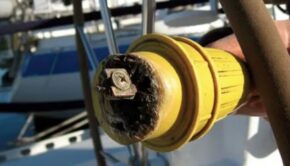Inflatable PFD Care and Use
Published on July 25th, 2018
by Darrell Nicholson, Practical Sailor
Some sad news this past weekend from the Chicago-Mackinac race prompted me to update, and repost this advisory from 2015 regarding the care and use of personal flotation devices. It’s a relatively long post, but if you depend on inflatable PFD, the text and accompanying links are worth reviewing.
The following account of the accident comes from Nick Berberian, Rear Commodore at the Chicago Yacht Club, which hosts the annual event: “At approximately 2:45 p.m. on Saturday Jon [Santarelli, age 52, aboard the TP52 ‘Imedi’] was moving toward the back of the boat—stern of the boat— to make a routine sail adjustment, unfortunately at that precise time, a large wave hit the boat, causing him to slip into the water . . . Jon was wearing a personal floatation device that is designed to automatically inflate when it comes into contact with the water. The crew members have reported that the device did not inflate. . . .”
The accident is particularly disturbing for me because Santarelli was an extremely experienced sailor, he was sailing with a very experienced and well-trained crew, and presumably was equipped with first-rate safety gear. As of yet, Santarelli’s body has not yet been recovered, so the reasons why the PFD did not inflate are unknown.
Most auto-inflate PFDs allow the wearer to disable the auto-inflate function, so it is too early to conclude that something may have gone wrong with the device itself.
It is important to make clear that despite the shortcomings of current PFD designs, they remain an essential tool for survival at sea. Without reservation, PS encourages boaters to wear the appropriate type PFD while sailing, in any boat and any water. At present, a properly maintained auto-inflating PFD has proven itself to be a versatile and effective device for everyday use when offshore sailing, where great mobility and an abundance of flotation is required.
However, it is important to recognize that auto-inflate vests are not our only option. Small boat and inshore sailors are often better served by a conventional inherently buoyant lifevest. It is important to weigh the pros and cons of each device when choosing the right one for a particular activity.
Full report… click here.









 We’ll keep your information safe.
We’ll keep your information safe.